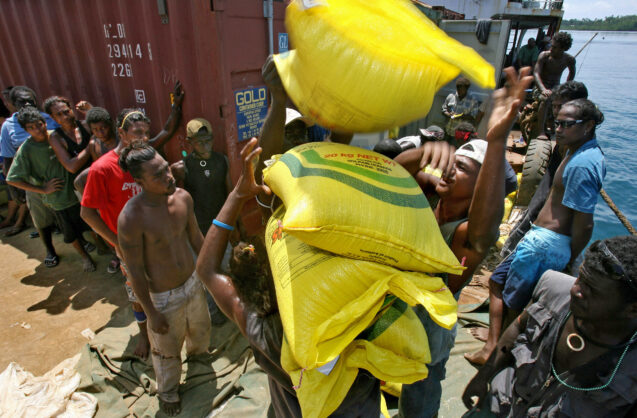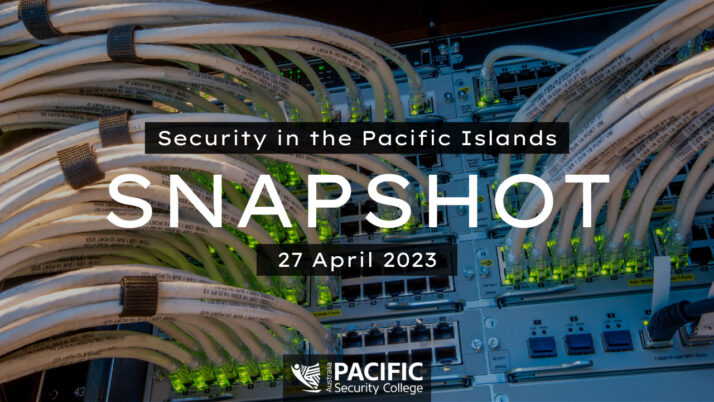Lessons from a decade of disasters: building community resilience in Solomon Islands

Locals line up to help unload a barge of Red Cross aid in the tsunami-hit town of Gizo in the Solomon Islands, 08 April 2007. (Photo by WILLIAM WEST / AFP)
Local solutions are required to boost community self-reliance in Pacific disaster response, writes Anouk Ride and colleagues.
In 2009, this author was in and around Gizo, Solomon Islands talking to people about the impacts of aid in the aftermath of a tsunami and earthquake for a book chapter. At that time, government officials, service providers, and local communities complained about uncoordinated, haphazard, and chauvinistic responses. There was a view that international organisations barged in with one-size-fits-all projects.
Community feedback relating to 2007 disaster response initiatives indicated that some never got off the ground due to poor planning. One housing project didn’t account for the lack of land tenure in i-Kiribati communities.
Others were hopelessly delayed for avoidable reasons, such as lacking funds to transport emergency supplies to remote islands. Others sidelined traditional and social support networks and many duplicated efforts, with some families showing piles of cooking pots and utensils provided by up to three donors.
One local non-governmental organisation (NGO) worker complained there was more competition than coordination, saying :“There was a lot of flag raising by the NGOs, it was like a competition, who is doing the best?… We should have been talking about how to improve things …I thought: ‘this isn’t helpful’. We didn’t want to go anymore [coordination meetings].”
Thankfully, by 2020, coordination had reduced waste and confusion in disaster response and put government back at the centre. So what changed?
In large part, it is thanks to new initiatives in the country which have prioritised coordination and local inclusion. The 2018 National Disaster Management Plan provided a platform for better coordination of disaster projects and assistance, whilst the Solomon Islands National Disaster Management Office (NDMO) orchestrated greater collaboration across stakeholders. This has been bolstered by disaster cluster coordinating committees – focusing on things like shelter, water, sanitation etc – which brought together agencies.
One of the greatest leaps forward has been the creation of an easily accessible common assessment tool – using Kobo Toolbox software – for improved data integration and management. Many communities now have their own disaster risk management plans, mostly formulated with the NDMO or international aid agencies, that cover basic preparations for disasters.
These system improvements were identified in a recent review of disaster resilience in the Pacific region. It found emerging area-based approaches provide a people-centred, locally-targeted and multisectoral way of working.
In the review, collaboration was described positively by 91 per cent of the interviewees from a range of government, non-government, and international organisations involved in disaster response.
However, there remained some scepticism about the rhetoric of local empowerment, with both government and local employees of international NGOs emphasising the need to understand communities’ interests and ways of organising rather than assuming what is ‘local’.
In 2009, people were frustrated by poorly delivered emergency supplies. Most preferred cash over other kinds of material aid, as it allowed them to better meet their individual needs and support local businesses. More recent trials of cash transfers in Solomon Islands and other countries have been successful.
The review also found that local solutions to boost self-reliance of communities need more attention. One of the best buffers against hardship after disasters are local food systems and community organised savings and support groups.
During COVID-19, women’s savings groups have allowed members in West Guadalcanal to cash out savings as their own ‘stimulus package’. These types of initiatives helped to support the 76 per cent of households in Solomon Islands that produce subsistence goods. There will be times when needs exceed local supplies, but local sources should be explored first, not last.
Other improvements in disaster response have flowed from the Australian Humanitarian Partnership (AHP), which aims to improve cooperation over issues such as geographic priorities, and provide agency leadership on pressing needs such as shelter or sanitation.
Additionally, local and international NGOs are finding ways to promote inclusive approaches to meet the needs of women and people with disabilities. This includes support to Women’s Weather Watch and work of People With Disabilities. Many in the review felt these had made a positive difference.
Even so, inclusion remains fraught and complex. Civil society groups reported feeling sidelined from recent COVID-19 economic impact decisions, such as those to do with stimulus funding coordinated by the Prime Minister’s Office. A few felt their partnerships with international NGOs was more as a service provider than collaborator.
The review found that government disaster and state of emergency funds were often exclusionary when distributed through discretionary funding administered by members of parliament, as often allocations were allegedly made based on personal political interests rather than need.
In urban and peri-urban areas, adaptation to disasters can be constrained by acute housing pressures and unclear land tenure. Informal settlements are often located on low lying areas prone to floods, or coastal areas prone to sea-level rise and surges. The steady flow of people to Honiara will continue as many seek urban-based services, employment, markets, and schools. As long as urban settlements remain largely unplanned and unregulated, urban vulnerability will escalate.
Despite the challenges, the last decade in Solomon Islands has seen disaster response benefit from local solutions.
The turn to ‘local’ in humanitarian and disaster assistance is an important correction to the externally driven ‘command and control’ and uniform responses of the past. There have been gains, but true resilience will require changing the economic and political structures that leave people affected by disasters on the periphery of power.
Dr Anouk Ride is an Affiliate Researcher with Australian National University and a Scientist with WorldFish based in Solomon Islands.
Contributors to this story include Prof Meg Keen, David Sanderson and Kira Osborne.
More Stories

Security Snapshot - 28 Mar 2024
Pacific Security Snapshot | 28 March 2024
Summary ➣ Heavy rains, floods, landslides and earthquakes batter the region ➣ Pacific submissions to the International Court of Justice (ICJ) on climate change responsibility ➣ Elections across the Pacific prompting changes to diplomatic relations and security arrangements ➣ Challenges for women in politics Climate Security Lives have been lost in PNG after a series…

Security Snapshot - 1 May 2023
Pacific Security Snapshot | 27 April 2023
The security stories shaping the region ➣ PIF eyes bolstering Pacific Island Countries’ cyber defences ➣ Australia releases its Defence Strategic Review ➣ Plan ANZAC signed ➣ United Kingdom Foreign Secretary visits the region ➣ Marshall Islands signs bilateral agreements with Taiwan ➣ Pacific Prevention Summit in Fiji discusses gender equality ➣ Vanuatu mitigating coconut…






